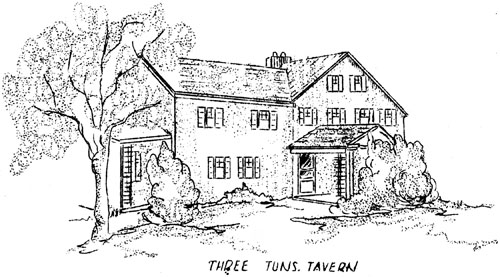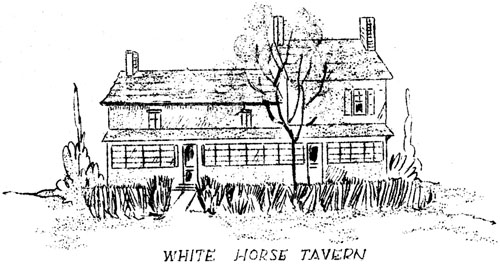|
Home : Quarterly Archives : Volume 3 |
Tredyffrin Easttown Historical Society |
|
Source: October 1940 Volume 3 Number 4, Pages 84–86 Battle of the clouds The Battle of the Clouds was fought on September 16, 1777. The American army, racing south, was in position on the South Valley Hills about where Immaculata College now stands. The King Road ran east and west along the American lines. The left was established at the Goshen-Frazer Road and King Road intersection stood the Three Tuns Tavern. It is a private residence today. It can be identified by a Three Tuns sign on the gate. The lines extended westward along the ridge. The English position was on a parallel ridge about one mile to the south along the Hershey Mill road. Thus, on the morning of the 16th the two armies faced each other on parallel ridges about one mile apart.
Three Tuns Tavern The two armies that faced each other were the American army of about eleven thousand men and the English part, about eleven thousand men, of the British army. The Hessian part of the British army was not on the field. They were farther west advancing toward the great valley in two columns, via the West Chester-Exton Road and via the West Chester-Boot Tavern-Ship Road. The picket lines of the Americans were thrown out on the low ridge that runs through the middle of the valley formed by the two high ridges on which the two armies were drawn up. The British advanced. They struck the picket line and fighting began. On the slope just east of the mill dam some sharp skirmishing took place. The skirmishing continued as the American picket lines slowly retired toward the main lines. But before the main bodies could contact the American army changed position. It moved from South Valley Hill ridge to a much more advantageous position about one-half mile to the north. Lines were formed at Plane Brook (Philadelphia Memorial Park) on the ridge that runs through the middle of the Great Valley. The English army remained on the South Valley hills all day, not offering to attack the Americans in their second position. At four o'clock in the afternoon the American army retired from Great Valley. This is the action that has become known as the Battle of the Clouds. It was really not a battle. The only fighting was between the American picket line and the advancing English. If a person takes this description and goes to the site of the battle he will be able easily to visualize the whole panorama of the battle spread out on the hills and valley before him.
White Horse Tavern Comment: Washington's main lines of defense were on the east bank of the Schuylkill River. From a position there, he could move to defend either Philadelphia or the American supply base at Reading, depending upon which of the two was threatened "by the English movements. When on the fourteenth and fifteenth Washington moved into the Great Valley, it was to take a tentative advance position. However, that position had to be so taken, that there were sufficient roads from it to the river, in order that he could quickly retire to his basic lines on the east bank of the river. He encamped at such a position on the night of the fifteenth at Plane Brook and Malin Hall on the Old Lancaster Road (today mistakenly called Swedesford Road, west of Malin Hall). It was a strong position with good lines of retreat open to the main lines on the river. Plane Brook was a road center. The Old Lancaster, the Conestoga and the Moore Hall Roads all pass through there. Over these roads, Washington could retreat from Plane Brook in case of defeat. Or in case of victory, the roads would be used to rapidly bring up supplies as Washington pursued his enemy. The second advance position on the South Valley Hills taken on the morning of the sixteenth, had the advantage of being a strong position at which to fight a battle. But it had the great weakness of poor lines for retirement or for changing position to protect the right. Another weakness of the position on the hills was that the right of the American line was greatly endangered by the Hessian advance on the west. The retirement to Plane Brook removed both of these dangers, for at Plane Brook, Washington had good roads over which to retire to his basic lines and also he was in position to frustrate any attempt on his right. Another reason for Washington's retirement to Plane Brook has been given. It is that on the sixteenth heavy equinoctial rains fell. As the skirmishing began, the rain wet the powder in the powder pans of the flint lock muskets, thus rendering them useless, and as the affair would then be one of bayonets, with which the British were much better equipped, retreat was advisable. This is not a very good reason. The same conditions existed at Plane Brook, but no retirement from there occurred until the withdrawal from the Great Valley at four o'clock in the afternoon. The storms and low cloud of the day, however, gave the name to the engagement of the Battle of the Clouds. (This article, the last written by our late president, is reprinted through the courtesy of the Daily Local News.) |

